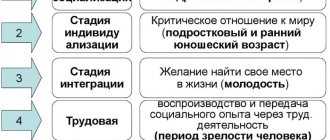negotiation
21.01.2022
Author: Academy-of-capital.ru
Add a comment
Rating:
| (No votes) |
From this material you will learn:
- Concept of perception
- Some features of the perceptual side of communication
- Examples of perceptual communication
- Functions of social perception
- Mechanisms of social perception that facilitate mutual understanding
- Perceptual mechanisms that can disrupt mutual understanding
- The perceptual side of business communication
From a psychological point of view, the perceptual side of communication is the basis of communication between people. It allows you to determine the inner essence of your interlocutor, which means finding an approach to him and even to some extent predicting his reactions to a particular event.
But this is only the case when the person was “read” correctly. If mistakes were made during the interaction, this can lead to an incorrect interpretation of the words and behavior of the interlocutor, which, at a minimum, will lead to misunderstanding, and at maximum, to the emergence of a conflict.
Perception
From a psychological point of view, this is an individual’s reflection at the cognitive level of those objects, phenomena, events with which he interacts. In the case of social interaction, it involves perceiving the other as a separate person with his own characteristics.
Awareness of the opponent's individuality can arise through understanding his beliefs, desires, interests and opinions. This is how an objective assessment of an individual is built, whose characteristics differ from the characteristics of the perceiver.
In this regard, acceptance can also be formed - a complete or partial sharing of the interlocutor’s attitudes and values. It is the foundation for the formation of higher-level relationships: friendship, sympathy, love.
Briefly: thanks to the perceptual side of communication, people are able to read from others what is not voiced and find an approach to them. An incorrect analysis can cause misunderstandings and even conflict.
First impression mistakes
Types of communication in psychology - what they include, its functions
Information enters the human consciousness from three sources:
- Visual perception, which forms a complex of visual images.
- An auditory source formed by a combination of sounds.
- The kinesthetic channel of management perception, built on sensations.
Important! Individual subjects of society are able to perceive and process data, focusing on three data sources. However, one channel is a priority; on its basis, the main perception, formation of thoughts and memories occur. Modality (qualitative characteristics of sensations) in people (visual, auditory and kinesthetic, respectively) is formed individually.
Inequality
It arises against the background of a superior parameter that is subject to a positive assessment, or, conversely, if the subject is superior to the object of communication, the second is underestimated.
Attractiveness factor
An important factor is whether you like the appearance of the interlocutor. Under the influence of one factor, there is an overestimation or underestimation of the partner’s properties. With a positive perception of external parameters, there is a high probability of perceiving a person as an intelligent, interesting person.
Distorted perception of the interlocutor
Attitude factor
Social science says that people who have a kinder attitude seem better than those who have a bad attitude. Positivity generates a strong tendency to attribute positive qualities; as soon as the negative is included, the person will stop noticing the characteristic features of the partner and will begin to highlight the negative ones.
Errors in forming first impressions are called the halo effect, which is triggered by a number of reasons: prospect superiority, attractiveness and attitude.
Functions of social perception and purpose
As a result of evaluating certain objects, various stable images of these objects or phenomena develop in the mind. This process directly affects the socialization of the individual:
- Self-knowledge. A person gets to know himself through the world around him, he receives information about himself during interaction with space. This is what I will teach you in my personal consultation. Sometimes the perception of the individuality of the interlocutor helps to identify important aspects for personal development, hidden interests, and aspirations.
- Getting to know other people. To truly get to know a partner, to understand his views and attitudes, to gain trust and to effectively develop communication is possible only in the process of establishing interaction at the perceptual level.
- Building joint activities. The basis for further building a common reality is understanding and acceptance. Without understanding the interests, beliefs and values of partners, it is impossible to create a model of effective contact with him. The more participants in a group who have to work together, the more significant the role of perception.
- Formation of emotional relationships. In the process of communication between people, certain emotions arise from sympathy, respect or hostility to love and hatred. Perceptual communication helps determine the attitude towards a partner.
The interactive side of communication
The parties to the communication process characterize the main components of communication. The interactive aspect of communication is associated with the interaction of subjects and the organization of their group activities. The goals of any communication depend on the needs of individuals in joint activities. Communication should always assume a certain result - a modification of the behavior of other subjects. Communicative interaction and joint activities are carried out under conditions of public control, based on social norms, behavioral patterns accepted in society, which regulate the relationships of subjects and form a specific system. The existence and acceptance of regulatory norms of behavior in society is evidenced by the same reaction of society to a certain action that differs from the actions of others. The scope of social norms is quite wide - starting from models of behavior that meet the requirements of work discipline, civil and military duty, and ending with the rules of basic education and politeness.
The appeal of subjects of communicative interaction to norms leads them to responsibility for their own behavior, helps to regulate their actions, subjecting them to evaluation and division into those that comply with and those that do not comply with the norms. Social control during communicative interaction is carried out according to the repertoire of roles played by the communicating subjects. Role refers to a normatively approved model of behavior expected by society from everyone occupying a certain social position. Such positions include age, position, etc. Each role occupied by a subject must meet certain requirements and expectations of others. Each individual can act in different roles (multiple positions), which often leads to role conflict. The interaction of subjects performing different roles is governed by role expectations. It follows that the initial condition for the effectiveness of communications is the adequacy of the behavior model of interacting individuals to mutual expectations.
The causes of conflicts in collective activities can be determined by substantive and business disagreements and differences in personal and pragmatic interests. At the same time, a distinctive feature of conflict situations of the second type is the build-up of emotional tension. Also, the causes of conflict situations are semantic barriers in communications that impede the establishment of successful interaction between those talking. A semantic barrier in communication interaction is considered to be a discrepancy in the meanings of the expressed requests, demands, orders for the participants in communication, which creates a barrier to mutual understanding and further interaction. Semantic barriers acquire a more significant role in pedagogical and business communication. This is due to the difference in age of the participants, different life experiences, differences in interests, etc. That is why the aspects of business communication between a business person and a teacher should ideally be equally developed.
The connecting link that unites the target orientation of the activity with the reasons for its implementation usually acquires special significance for the subject. After all, the same act, word, circumstance can carry different meanings for different people. Therefore, during communication interaction, the ability to put oneself in the position of another participant in communications is of utmost importance.
Perceptual component
It helps to correctly interpret the appearance and behavior of a person when interacting with her. Without it, our ideas about others would be superficial and ineffective.
Thanks to perception, real thoughts, ambitions, and experiences do not escape our consciousness. However, it can manifest itself fully only if a person is not hostage to stereotypes and limiting beliefs. They do not allow you to objectively analyze the interlocutor and create a certain image in your head in advance, which is often far from reality.
Psychologist Daria Milai
Make an appointment
It is necessary not to rush to conclusions and allow yourself to form a reliable assessment. To get a truly accurate picture of your opponent, you need to communicate with him for a long time, get as much information as possible by observing his behavior in various situations.
It's probably happened that you've met someone you knew in the past and noticed how much they've changed. It becomes possible to reject the already formed perception of his personality and accept the characteristics that he has at the moment.
Interactive side
If there are usually no difficulties in understanding the meaning of the communicative side, then the interactive side raises many questions. Interaction is understood as the activity of the participants in communication, their interaction.
3 sides of communication
Interaction can be viewed from several perspectives. First of all, this is how contact is made - in person or using different means of communication - telephone, PC, and, accordingly, instant messengers, email.
Additional tools are used not only in personal communication, but also in business and education. Remember that today schools and universities organize the educational process remotely.
On the other hand, the interactive side refers to what roles the participants in communication take on.
The most famous scheme includes three roles:
- Adult. This person knows how to take responsibility for communication and is able to make decisions. He does not use any games in interaction, does not imagine himself in the role of a victim, and does not seek to lecture his partners. Clearly understands what he needs and what he can do to achieve the goal.
- Parent. A person in this role is inclined to demand submission and obedience, to teach, to convince from the position of a wise parent. He rarely objectively evaluates his role, as well as the role of other people. His motto is “must”, without any explanations or arguments.
- Child. The communication partner, playing the role of a child, submits to desires and demands that others satisfy his needs. He does not want to adequately assess his capabilities.
A similar pattern of interaction can be observed in communication with family, friends, and at work.
But the interactive side can also be considered from the point of view of the direction of communication. Interaction will be productive when the parties are inclined to coordinate joint actions. Together they are determined to achieve common goals and respect each other’s interests.
Communication can be based on competition. Of course, business organizations and competitions immediately come to mind. However, members of the same family – parents and children, brothers and sisters – can also compete. Example - a child plays chess well, the dad’s goal is to prove that he plays better and can win.
If cooperation always plays a positive role, then the position of competition is twofold.
The third type of relationship in communication is based on conflict. One or both parties consciously strive for quarrel, drama, mismatch of interaction.
Aspects
Perception first appears at the stage of visual analysis of the communication object. Thus, physiognomy claims that there is a connection between an individual’s facial features and his psychological characteristics. Based on an assessment of the interlocutor’s appearance, the first assumptions are made regarding his inner world and behavior.
Then some emotional contact is formed. If the conversation has an unpleasant context, a negative perception of the opponent may well be formed. And vice versa.
In the process of communication, people observe their partner’s speech, facial expressions, gestures, and habits, receiving verbal and nonverbal information about his personality.
Some features of the perceptual side of communication
Perception is a psychological process responsible for the effectiveness of human communication and its results. The characteristic of the perceptual side of communication is a set of features, in particular, we are talking about the following aspects:
- the activity of all people participating in communication;
- their motivation;
- comparison of the external characteristics of an individual with his characteristic character traits;
- interpretation and prediction of his actions and words;
- observation and study of such non-verbal forms of communication as gestures, postures, facial expressions, intonations, etc.;
- ability to accept feedback;
- the ability to analyze and correctly recognize the interlocutor’s reaction, etc.
Mechanisms of social perception
The perceptual side of communication includes several important tools that allow you to establish effective interpersonal interactions.
Reflection
This is the ability to analyze your actions, draw conclusions from what happened and see possible ways of developing the situation. In building communication, it is relevant at the moment when we are trying to visualize the impression we make on our opponent. The result may or may not meet expectations.
To reflect means to be able to look at the process from the outside, analyze what is happening and try to get to the essence of the problem through rational understanding.
Identification
Identifying oneself with the interlocutor, trying to put oneself in his place and look at the problem through the prism of his perception. This mechanism allows you to better understand and accept the speaker’s position.
Empathy
Represents the ability to empathize and sympathize. The more subtle a person’s mental organization is, the more developed his empathy is. Such people can analyze the internal state of their opponent simply by observing his behavior.
Anthropological, social and aesthetic stereotyping
An assessment of an individual's psychological characteristics is based on various stereotypes. Thus, many believe that deep-set eyes indicate toughness and secrecy, and weak hands indicate a lack of hard work. Personal status, financial situation, and external attractiveness are also taken into account.
Attraction
An assessment of an individual that is based on a stable, long-lasting positive feeling towards a partner. It promotes the formation of closer interpersonal connections: friendship, love, affection.
Casual attribution
Interpretation of phrases and actions of the interlocutor based on personal assumptions and previous experience. This is an attempt to find out the reasons for this or that behavior, but not through observation and obtaining information, but based on one’s own prejudices and conclusions.
Face-to-face consultation
What are the features and advantages of face-to-face consultation?
Find out more
Skype consultation
What are the features and benefits of Skype consultations?
Find out more
Practical implementation of perception
The element in question allows a person to competently interpret the appearance and behavior of the interlocutor. Based on the information received, a person forms his own conclusion about the distinctive personality traits and motives of actions. Perception has a great influence on the effectiveness of communication. With its help, the internal state of the interlocutor is analyzed.
Social perception allows you to correctly perceive surrounding objects and establish communication with them. The effectiveness of social perception directly depends on how much a person is not influenced by stereotypes; they have a negative impact on the objective assessment of the interlocutor, the result is the formation of a distorted image in the mind.
Mechanisms of perception
In communication, it is important not just to categorize the opponent by attaching one label or another to him, but to understand, to immerse deeply in the inner world of the partner, to realize his current emotional state, motivation, and attitude to the situation.
However, this is not only the interaction of persons A and B. At the end of the 19th century, Professor J. Holmes described the process of interpersonal communication in an expanded scheme. As many as 6 subjects were included in it. So, who actually participates in the conversation between the conditional John and Henry:
- D., what it really is.
- D., as he perceives himself.
- D., as G. sees him.
- G., what he is.
- G., what he considers himself to be.
- G., as assessed by D.
Later we added one more point to this picture:
- D (G), how he sees his image in the opponent’s head.
Organizational communication system
Each organization is characterized by its own communication system, which can be figuratively described as the “circulatory system” of the organization through which information circulates.
An organizational communication system is a set of formal and informal communication channels that connect elements of an organizational structure.
In the subsystem of formal organizational communication there are several flows: ascending, descending, horizontal and diagonal. The top-down flow performs the functions of transmitting orders, directions and instructions, as well as motivating and evaluating employees. Middle managers act as a kind of “filters” that regulate the amount and content of information passing through them from top to bottom of the organizational pyramid. Upstream has the function of obtaining information from management about the activities and sentiments of employees at lower levels: This includes reports, opinions, complaints and requests for support and assistance. As information rises to higher levels of management, it is filtered and takes on a compressed, generalized form. To obtain objective information about the state of affairs, regular meetings with staff, interviews and questionnaires of resigning employees are widely used, complaint filing systems are being introduced, etc. Horizontal and diagonal flows perform the function of coordinating and solving current problems and connecting people who are at the same hierarchical levels or are not connected by direct subordination. Horizontal communication is more effective for solving operational problems and is less prone to failure.
The construction of a communication network in an organization depends on a number of organizational factors: Size, scope and structure of the company, organizational culture, management and decision-making style. Modern innovative and intelligent organizations strive to build decentralized communication networks that ensure maximum openness and accessibility of information to a large number of their employees. Having complete information is no longer the privilege of top managers. At the same time, optimal communication networks should not have excessive information redundancy.
In addition to the formal organizational communication system, informal communication plays an important role. The main function of informal communication is to satisfy employees' needs to establish friendships and respect, as well as to exchange personal information. When information about a company is scarce, it may also relate to professional activities. One of the features of informal communication is the high speed of information transfer, which cannot be compared with formal channels. Most often, information spread by word of mouth is accurate; when it is unreliable, it is rumor that can disrupt the company's operations. Informal communication “overlays” the formal communication system, complementing or disrupting its work.
The organizational communication system as a whole reflects the information needs of the structure of activity and power in the organization. Increasing the efficiency of this system occurs due to its optimal design and personnel training.
Phenomena (effects) of interpersonal perception
Primacy. The idea is that if there is conflicting information after meeting an individual, the facts obtained earlier are perceived as more significant. It is they who influence the formation of a general idea of the stranger’s personality.
- Extremes. Objects located on the edge are remembered better than those located in the middle.
- Novelty. In the case of the perception of a familiar person, data obtained later takes on greater significance.
- Halo. It is the formation of a unique belief associated with the observed through the purposeful attribution of a number of characteristics to it, that is, the learned facts are superimposed on the initially existing image. Thus, a general positive impression contributes to a positive assessment of the known and unknown qualities of an object, while a negative attitude towards it gives rise to deliberately negative assessments.
- First meeting. Assumes a stable conclusion about a person that arose after initial communication. This is especially relevant when future opinions about an individual contradict the existing prototype.
- Projections. In general, people tend to attribute their positive qualities to a pleasant interlocutor, and their own negative qualities to an unpleasant interlocutor.
- Average error. The tendency to soften the assessment of the most striking characteristics of an individual to the statistical average.
- Barnum. Perception of assessments of one's identity as truly true if they are presented through the prism of a scientific, ritual or magical context.
- Boomerang. The information that is presented to the audience causes the opposite effect to the expected one. This is possible when the subject reporting the fact is unpleasant to the group or when its members do not trust the source of the data.
Communication process model
There are several models of the communication process, the most famous of which is Harold Lasswell's concept.
This model originally included five elements, but Lasswell eventually added two more to it, changing the rest slightly. Original model:
- Who? (communicator, source of information, that is, the person who transmits information).
- What? (message sent by the communicator).
- On what channel? (method of transmitting information).
- To whom (recipient, recipient - this can be either one interlocutor or a whole audience).
- With what effect? (reaction to the message received, assessment of the effectiveness of communication).
Augmented model:
- Who? (communicator).
- With what intention? (Lasswell considered this question the most important, because without the motives and goals of communication it is impossible to talk about either channels or the target audience - that is, about communication in general).
- In what situation? (the situation can be of three types: favorable, neutral, unfavorable).
- With what resources? (resources should be understood as the communicator himself, as well as technologies, financial means and methods).
- Using what strategy? (Lasswell believed that every communicator should choose a strategy before speaking, and not just leave things to chance).
- For what audience? (if you know who your audience or interlocutor is, you can persuade them much more effectively).
Characteristics and features of stereotyping: how the perceptual side of communication is manifested in it
Perception is closely related to stereotypes existing in society. Their formation in the process of communication can occur under the influence of a number of circumstances:
- The superiority factor. It occurs in a situation of obvious inequality between interlocutors in a certain area: in terms of financial status, social status, intellectual abilities. A person often overestimates the characteristics of those who are superior to him on a characteristic that is significant to him. Conversely, feeling our advantage, we often underestimate our opponent.
- Degree of attractiveness. One way or another, our perception depends on the emotional component, in particular on sympathy or antipathy. Outwardly attractive people are seen as happier, more confident, and more successful.
- Factor of attitude towards us. As a rule, individuals who treat us well are perceived favorably. Conversely, those who evaluate us negatively appear worse.
All these distortions can most often be observed when forming a first impression of a person. However, to build effective communications, it is worth remembering that stereotyping interferes with an objective analysis of personality.
Ask a question
Communication barriers may also arise when transmitting information. They lead to distortion of the transmitted message and cause misunderstanding between the participants in the conversation:
- use of jargon, unfamiliar words, terms;
- the presence of emotional inhibitions (thoughts and feelings that are difficult or prohibited to demonstrate to another individual);
- lack of interest in the subject of conversation;
- differences in point of view;
- physical disabilities (hearing or speech problems);
- inability to analyze the behavior and state of a partner due to the characteristics of the communication channel (telephone, Internet);
- linguistic or dialectical differences;
- the desire to hear what one wants, and not what actually is;
- differing cultural norms;
- difference in worldview and worldview.
It is simply impossible to get rid of barriers when establishing communication. The spoken remark always reaches the addressee in a distorted form, passing through several levels of his internal “filtering.”
What happens is that during a conversation, the communicator encodes the text, and the recipient decodes it. That is, when wanting to convey information to the interlocutor, it is necessary to isolate its general meaning, which must be conveyed and then “encrypt” it using verbal and non-verbal symbols. When providing feedback, you can understand whether the transmitted ciphers were correctly perceived and interpreted.
To build the communication process as efficiently as possible, you need to know the context in which the dialogue is being built:
- In what social event does it occur?
- Is this formal or informal communication?
- Is this a chance meeting or should the interaction continue in the future?
- Are you included in the game format? Is the problem being discussed serious and real?
Based on the answers to these questions, you can choose the appropriate behavior style:
- Humanistic. Aimed at mutual knowledge of the inner worlds of opponents, which generates empathy.
- Manipulative. An attempt to impose your position on the interlocutor. The mechanism can be used in both positive and negative ways.
- Ritual. Assumes the presence of actions expected within a given cultural framework.
Transactional analysis will also help to establish contact. This is a way of organizing communicative interaction based on regulating the positions of opponents. The personality of each person includes three roles: parent (talks about what needs to be done), adult (harmoniously combines desire and necessity) and child (relies solely on emotional “wanting”). To communicate effectively with people, you need to ensure that these categories coincide. Otherwise, there is a risk of not being able to correctly perceive what was said.
By understanding the context and choosing the appropriate conversational style, you can steer the conversation in the right direction.
Examples of perceptual communication
For a better understanding of what the perceptual side of communication is, we will give examples.
The formation of perceptual communication skills occurs from childhood, when the baby learns to recognize and understand the facial expressions, intonations and emotions of his parents. The complexity of perception mechanisms directly determines the number of factors that an individual can perceive in the process of communicating with others - the more complex the mechanisms, the more there will be.
These factors contribute to the formation of the most complete opinion about the interlocutor and his characteristic features thanks to the information obtained.
We recommend
“7 Active Listening Techniques” Read more
Another example. The emergence of interest in another person leads to the manifestation of vigorous activity aimed at finding out the maximum possible amount of information about a new acquaintance with the help of questions. In this way, a better understanding of his internal qualities, judgments and attitudes can be achieved.
The perceptual side of interpersonal communication leads to a person’s faster adaptation to a new social group. This occurs due to the fact that in the process of communication the individual tells others about himself and receives feedback from them.










